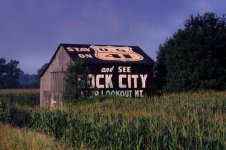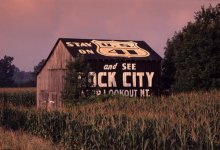How can we increase demand for Provia 400X. By pushing Provia 100F?!
Yes, exactly. Provia 100F is excellent at ISO 200/24°, and still good at 400/27°.
So we can at least compensate Provia 400X demand a bit.
That in a first step leads to an increasing demand for Provia 100F.
And when the market further stabilises and increases again, that could be the signal for Fuji to re-intruduce Provia 400X.
That is the way E6 started: First with ISO 50, 64, 100 films. Then the demand increased and later higher speed films were introduced, too.
And it is the same with Ektachrome: If the demand for 135 is increasing, they will also offer 120 later.
Result: The more Provia 100F and Velvias we are shooting, the higher the likeliness that more options like Provia 400X, Astia 100F, Ektachrome options will come back to the market.
The demand is the essential factor.
On the other hand I wish we could get some feedback from Fuji. Apart from "totally committed to film" (which film? Instax?). If you look for information you can find more or less regular and more or less official statements from virtually every other film manufacturer. Except from Fuji.
That is right. PR and marketing for their conventional films is indeed their weakness. But it looks things are slightly improving there. They just recently started activities on Instagram.
Maybe if we knew which film has the most solid future we could do something about it? Lets say I can buy 100 rolls of slide film per year. Maybe 50 rolls of Velvia and 50 rolls of Provia is too low for both, Velvia and Provia, but 100 rolls of Velvia could keep at least Velvia line rolling for another year?
Provia and Velvia are outstanding films, unsurpassed in its classes.
Shooting both is the best we can do.
I am shooting Provia 100F as my allround material, and Velvia 50 in the situations I need / want higher saturation. I take Velvia 100 when I need more speed than Velvia 50.
But as Velvia 50 and Velvia 100 are indeed different in colours and contrast, I generally prefer Velvia 50 and I am shooting it more compared to Velvia 100.
I'm past thinking that the greatest thing about film is diversity and that you get totally different "sensor" with every type of film (this got me into film).
I agree. That you always can change the "sensor" with film immediately is a really big advantage with film. Not only in the past, but also today.
My friends/family get much better quality when I scan the film. The difference is MASSIVE. Sometimes they can see absolutely NOTHING if I don't scan.
I show my slides to family and friends on a light box and / or in projection.
So they get by far the best quality, and they enjoy it.
And I can avoid the time consuming (and quality decreasing) scanning process.
Since I started taking pictures only recently, I wonder where have all the folks as Dave, nikonhswebmaster and Jan gone? Or how many of them were there at all back in the day? Because, obviously, digital didn't bring anything (good) to them and the negative film isn't an option. Why is slide film doing so poorly? Who is still abandoning it and why?
The reasons are the following:
1. Reversal film has had a huge demand basis in professional photography. The professional photo market is 98-99% digital now.
2. Enthusiasts: Reversal film is a high(est) quality medium.
But the enthusiast market today is mainly a low to medium quality market, both in digital and film.
Because most users just view their results only on quality reducing 2k / 4k monitors.
The high resolution of 24, 36, 50 MP cameras is destroyed by the lowest quality element in the imaging chain, the computer monitor with its extrenmely low resolution of 2 - 8 MP, and its inability to show real half tones because of the discrete LCD structure.
The same is valid for the scanned films viewed only on monitors.
The whole marketing is focussed on that lowest quality viewing medium. Also again both digital and film.
All the film bloggers (= influencers, lots of them are sponsored), youtubers, Lomography, Kodak, the Kodak dependant marketing labs like Indie etc. also all promote this lowest quality imaging chain with film.
Countless articles on these blogs about cheap film scanners (flatbed) and scanning film for only monitor use.
Just one example for that nonsense:
First they get crazy about "the medium format quality", then they recommend buying a cheap flatbed scanner to scan medium format and view it on a monitor.
With the flatbed scanner you destroy the medium format quality completely (resolution loss of up to 80%, severe dynamic range and colour range loss), the monitor adds further limitations.
A 35mm negative / slide printed optically siginificantly surpass a MF flatbed scan in quality.
Same is valid for a 35mm slide on a light box with loupe, and of course in projection, too.
Most of the current film bloggers, youtubers are (very) young people with very little photographic knowledge. And lots of them are socialised by Lomography.
So the stupid Lomo marketing brainwash is still quite prominent in their minds.
How much of these young bloggers, youtubers have ever seen a slide on a light box with one of the outstanding Schneider or Rodenstock loupes?
None.
How much of these young bloggers, youtubers have ever seen a slide projection with one of the outstanding Leica or Rollei slide projectors with the unsurpassed Leica Super-Colorplan or Rollei AV-Apogon or Schneider AV-Xenotar lenses?
None.
How much of these young bloggers, youtubers have ever made an optical print by enlarging with an APO-Rodagon or APO- Componon lens?
None.
So these guys want to tell you something about quality, but they have never seen and never used by themselves the best quality tools and imaging chains.
Therefore they don't know what they are talking about.
And lots of these bloggers, youtubers have either never used reversal film at all, or only 1-2 films.
Instead they are telling their audience stupid comments and prejudices about slide film.
There has been a lot of reversal film bashing by these sources.
Unfortunately thousands of young film beginners follow these "hip" bloggers and just avoid to try reversal film by themselves.
I don't believe in preaching "just buy slide film" to the people that are already buying slide film.
The user base must get wider. More young film photographers should try reversal film.
Therefore this counterproductive slide film bashing of the last years must stop.
Film choice is not a "either - or".
Variety is great.
Shooting negative
and reversal film is about getting the optimum joy from film!
Cheers, Jan



